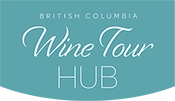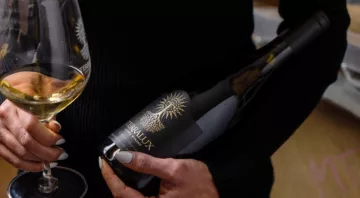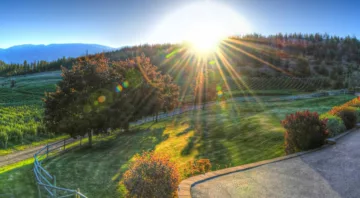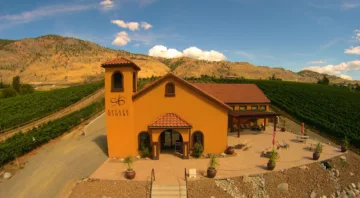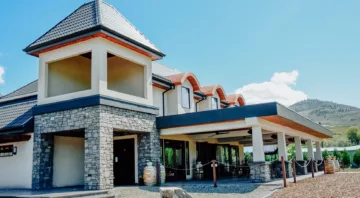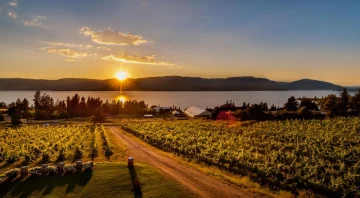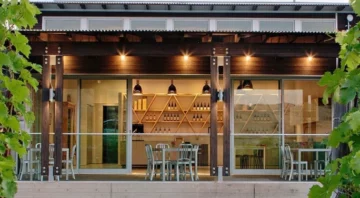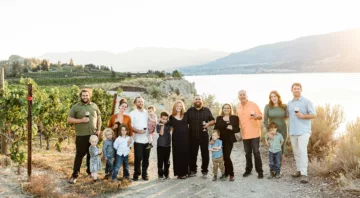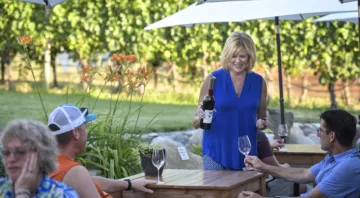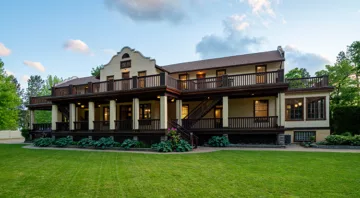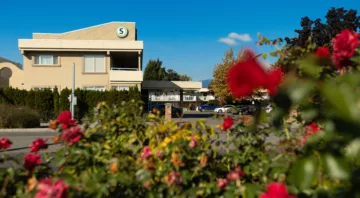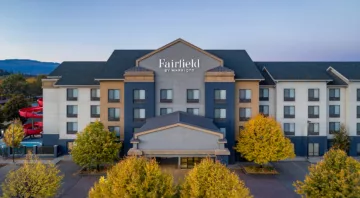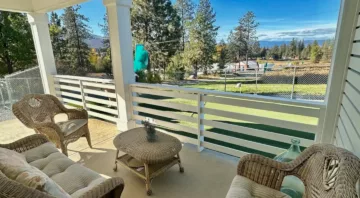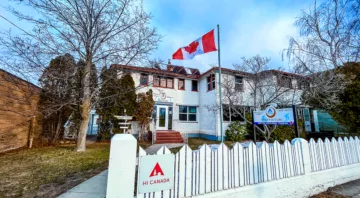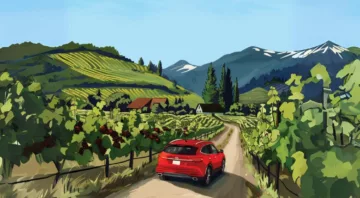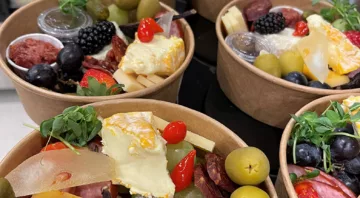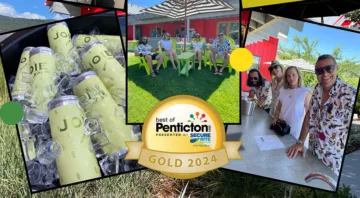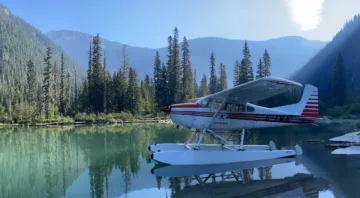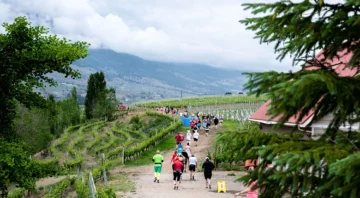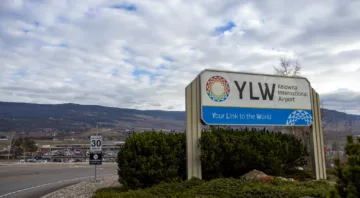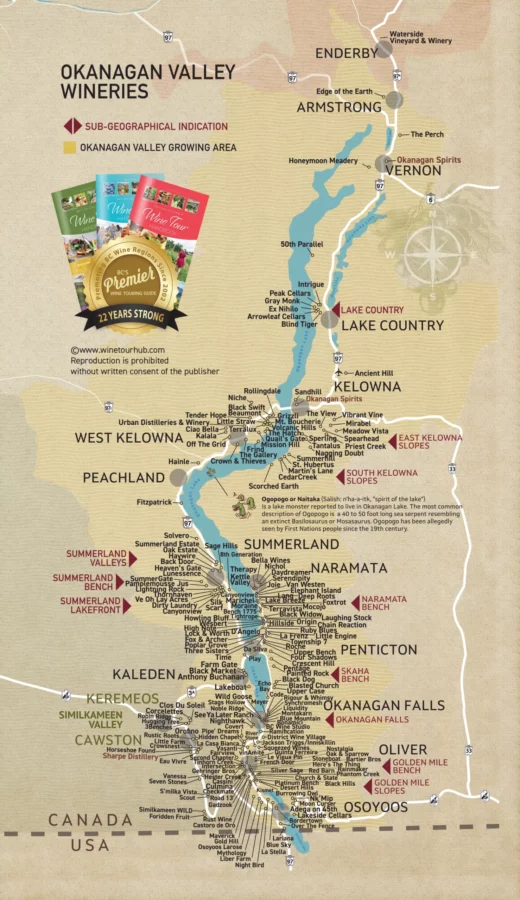
The Okanagan Valley Wine Region
Food and Wine Magazine describes the Okanagan Valley as “a place of dramatic contrasts.”
“Formed by glaciers and volcanoes, it’s a destination where lakeside beaches meet bluffs and steep hillsides striped with vines give way to valley floors speckled with stone-fruit orchards.”
“It’s long been a playground for city dwellers in Vancouver and Calgary, who pop over for weekend jaunts, but now, its wineries and farm-to-table restaurants are calling to travelers from all over the world.”
We couldn’t describe it better ourselves.
If you fly into the valley via Kelowna International Airport, you’ll first be struck by Okanagan Lake, which cuts a stunning 135 kilometre swath through the surrounding hillsides. But be prepared for a lot more drama as you explore the valley and the ecological wonders it has to offer. The communities from the north part of the region south to the American border at Osoyoos are connected via Highway 97.
The Okanagan Valley is the largest of the nine Geographical Indicators in the province and contains 11 of the 12 sub GIs. It is part of the Okanagan Thompson Indigenous area where the NLaka’pamux, Okanagan and Secwepemc First Nations culture is bound to its desert landscapes, fertile soil, dense forests, mountains, and fresh water. Indigenous cultural experiences are countless and winemaking plays a significant role.
Click on titles below to expand view of regional information and Okanagan winery maps
South Okanagan: Oliver & Osoyoos
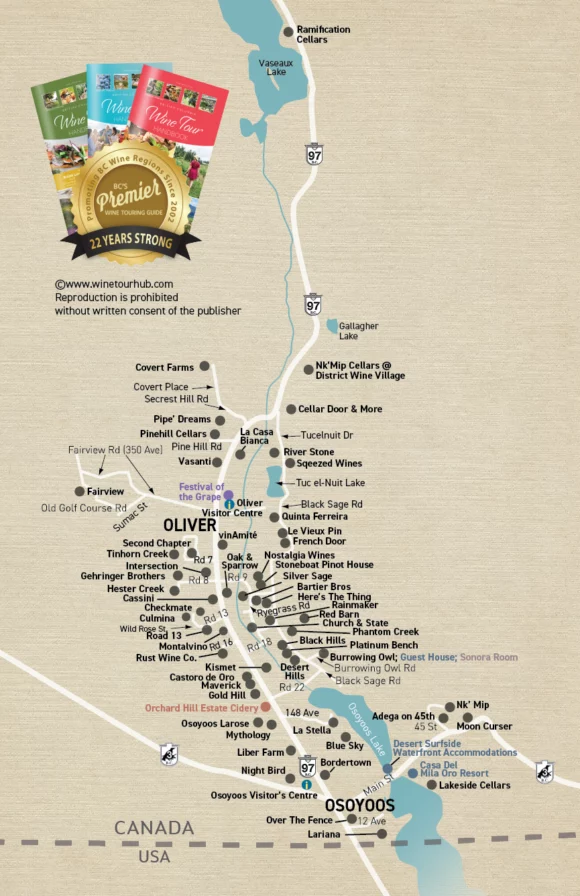
As you head south from Oliver to Osoyoos at the US border, the unique terrain consisting of large swaths of grape vines and fruit trees lining the rolling landscape along Highway 97 should not escape your notice.
The vivid green foliage are in sharp contrast to the dry, brown hillsides that make up the surrounding terrain. It seems out of place – and it is. Left to its own, this fruitful landscape would actually produce very little. The Oliver-Osoyoos area is in a desert belt – an extension of the Sonoran stretching up from Mexico. Cacti and rattlesnakes are more at home here and there’s an interpretation centre where visitors can experience Canada’s only desert and explore Indigenous culture.
Fertile ground for growing grapes and fruit has been made possible by the use of irrigation, which has given new life to the South Okanagan. The area’s extended days of heat and sunshine has made it possible to grow varieties not previously thought possible.
Today, in this short stretch of the province, you will find more than half of the grape acreage in British Columbia. So it should come as no surprise that the local chamber of commerce declared the area as the “Wine Capital of Canada.”
If you are looking for a wine-soaked adventure, then the Oliver-Osoyoos region cannot be missed. Here you’ll find more than 60 wineries and British Columbia’s first official sub-geographical indication (sub-GI), the Golden Mile Bench, recognizing it for its unique climates, soil types and wine styles.
Oliver-Osoyoos is where the majority of the “big reds” are grown – Syrah, Cabernet Sauvignon, Cabernet Franc, Merlot – varieties that need an extended growing season and plenty of sunshine and hot.
And this is Canada’s hot spot – literally. It routinely tops the list as the hottest place in the country during the summer. Average daily highs are in excess of 29 C in July, but temperatures in the high 30s and low 40s are not uncommon.
From July through October, you’ll find roadside stands offering fresh cherries, apricots, peaches, pears, plums and apples. And, of course, year round wineries will offer up their own bottled bounties made from the grapes and selected tree fruits harvested each year.
Osoyoos is the southernmost point in the valley and located on the shores of the warmest lake in Canada. It’s a border town with easy access to the U.S. for those who want to make a quick trip stateside.
Despite recent development of luxury hotels and residential communities, Osoyoos has managed to retain its small-town charm offering idyllic respite with all the amenities you might desire at your fingertips. Dining in the area has been elevated in recent years, with a nod toward regional and season cuisine.
Gorgeous beaches and family-friendly options are plentiful in this stunning lakeside community. Awesome hiking and biking trails and backcountry adventures are close at hand.
Common varieties grown: Merlot, Syrah, Cabernet Sauvignon, Cabernet Franc
Key Wine Events: Festival of the Grape (September), Half Corked Marathon (May), Okanagan Spring Wine Festival (June), Okanagan Fall Wine Festival (October)
Average Daily High Temperature (July): 30C
Average Hours of Sunshine: 2039
Average Annual Rainfall: 250mm
Soil: Deep sand over bedrock, gravelly loamy sands
South Okanagan: Okanagan Falls & Kaleden
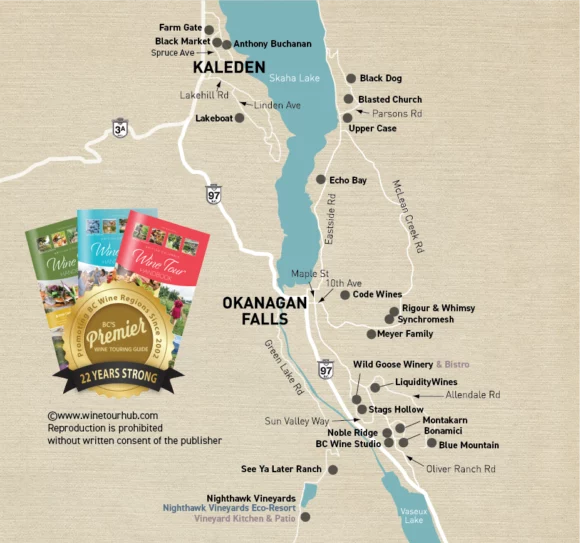
When you make your way through the community of Okanagan Falls, there will be one thing that will probably not escape your notice. The “falls” themselves don’t actually exist.
Originally, a robust set of twin falls fell from where Skaha Lake empties into the river, however, in 1946, a series of dams were built to control flooding. Don’t despair, Okanagan Falls and the community of Kaleden, located south of Penticton, still serve up plenty of charm and best of all, a thriving wine growing hub.
The first winery opened in 1986 and now about 20 can be found along the region’s winding roads. Many of them are members of the Okanagan Falls Skaha Lake Winery Association, at which Okanagan Falls is the centre, stretching north along the east bench of Skaha Lake, across the water to Kaleden and south over the hills of Vaseux Lake.
The association describes this area as a “unique climatic zone known as a semi-arid steppe, the finale stage of a desert area that extends up from the United States. Along with that comes long warm days and cool nights that retain the acidity in the grapes and helps shape their distinctive character and flavours.”
It’s this unique terroir that has prompted Okanagan Falls to be recognized as a Sub-Geographical Indication of the Okanagan Valley. Many of the wineries have embraced this terroir to craft products with individual signatures to critical acclaim. You’ll find organic, biodynamic, rustic and sophisticated wines made here.
The Okanagan Falls and Kaleden area harkens back to a simpler way of living. You won’t find any big box stores here, but if you’re in need of some retail therapy, you’ll be delighted by the eclectic mix of antique stores and craft shops, plus a flea market.
The area is a huge draw for nature lovers as a large selection of wildlife lives in the area, with many unique desert flora and fauna for naturalists to explore. A bird sanctuary is situated at Vaseux Lake just south of the town, complete with an interpretive centre.
Common varieties grown: Riesling, Pinot Noir, Gewurztraminer
Key Wine Events: Okanagan Spring Wine Festival (June), Okanagan Fall Wine Festival (October)
Average Daily High Temperature July: 29C
Average Hours of Sunshine: 1925
Average Annual Rainfall: 297 mm
Soil types: Terraced slopes with clay, sandy loam, gravel
South Okanagan: Penticton & Naramata
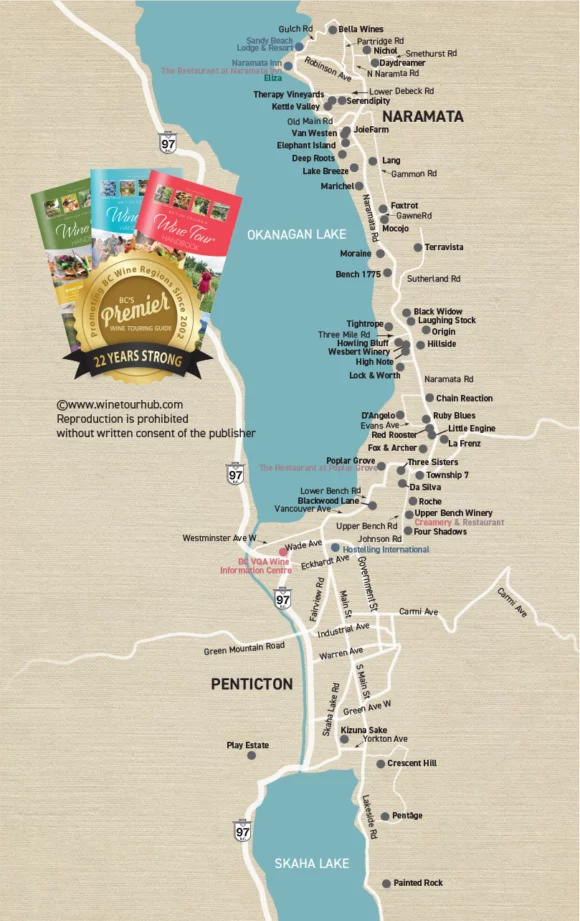
If you find yourself on the picturesque winding roads of the Naramata Bench, it will likely strike you how far away the trappings of urban life seem. Yet this pastoral, vineyard nirvana with its scenic lake views is but a few minutes from downtown Penticton, the third largest city in the Okanagan Valley.
Penticton is a pretty city with a small-town feel and situated on the banks of Okanagan and Skaha Lakes. For water enthusiasts, there are long stretches of shoreline with plenty of public beaches and access to a myriad of marine sports and activities. There’s a river channel that winds through the heart of the city and visitors can leisurely float the entire length on tubes and other floatation devices from one end to the other. This activity has been highlighted in the book titled, The Great Canadian Bucket List.
The city has been referred to as the “festival capital” with a wide range of annual events such as the Fest of Ale, Peachfest, Pentastic Hot Jazz Festival, Elvis Festival and the Ironman Triathalon. Signature events for the Okanagan Fall Wine Festival are also held here.
Outdoor adventure seekers will appreciate the wide range of trails for hiking and biking and the city is just minutes from Skaha Bluffs, a climber’s paradise that has garnered international recognition.
There are two Sub-Geographical Indications for wine production on the outskirts of Penticton. On the north side of Okanagan Lake is the Naramata Bench, where you will find one of the highest concentrations of wineries in the Okanagan Valley. It’s a great destination for a day trip and if you don’t mind the occasional hill climb, this is a sensational spot for a winery cycle tour. Some tour outfitters are even offering full electric and pedal assist bikes.
Further south on the eastside bench of the Skaha Lake you’ll find another small cluster of wineries. Many locations in this Sub GI area offer sweeping lake and hillside views.
Common varieties grown: Merlot, Pinot Gris, Chardonnay, Pinot Noir, Pinot Blanc, Syrah, Cabernet Franc, Cabernet Sauvignon
Key Wine Events: Okanagan Spring Wine Festival (June), Okanagan Fall Wine Festival (October)
Average Daily High Temperature July: 29C
Average Hours of Sunshine: 1923
Average Annual Rainfall: 299 mm
Soil: Glacial lake sediments components of silts and fine sands
South Okanagan: Peachland & Summerland
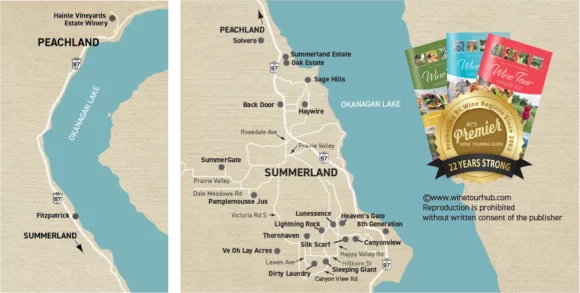
If sun-drenched beaches appeal to you then the communities of Peachland and Summerland will not disappoint. Tie this in with a backdrop of rolling mountainside and a broad range of eclectic wineries and you have a pretty dreamy vacation destination.
Both communities are set along the shores of stunning Okanagan Lake just off Highway 97 between Kelowna and Penticton, which both have airports offering regional daily flights.
Peachland and Summerland offer clean waterfront access for boating, paddleboarding, and so much more, as well as walking, hiking and biking trails and golf courses.
These communities are known for their quaint, friendly hospitality. And wine lovers will find several pockets of producers, some located right off the highway, while others are dotted along the hilly landscape. Enthusiasts will be especially drawn to the “Bottleneck Drive” in Summerland, a meandering path leading visitors to more than a dozen wineries, cideries, and distilleries. There is literally something for everyone no matter what your poison. And they are all closely grouped, making a cycle tour an appealing option.
This area offers a truly grassroots feel and artistic vibe. Expect to be entertained by local musicians, and enjoy the works of artists and crafters. This is an area rich in creativity.
It’s also a foodie’s paradise, with local producers and restaurateurs embracing the concept of the 100-mile diet – regional cuisine that promotes local, seasonal ingredients.
Common varieties grown: Riesling, Gewurztraminer, Pinot Noir
Key Wine Events: Grand Sommelier Express (June), Okanagan Spring Wine Festival (June), Okanagan Fall Wine Festival (October)
Average Daily High Temperature (July): 27C
Average Hours of Sunshine: 2057
Average Annual Rainfall: 307 mm
Soil: Fertile ice age clay and rich volcanic soils.
Central Okanagan: West Kelowna, Kelowna & Lake Country


The Central Okanagan is the go-to area of British Columbia Wine Country if you are looking for a combination of city life, outdoor adventure, sun-soaked beach days, marine activities, golf and all the wine you could possibly drink.
The region is home to Kelowna, the Okanagan Valley’s most populous city, and although you’ll now find 20-storey-plus buildings here, this community is rooted in a rich agricultural history. And it’s where BC’s wine industry got its start.
Father Charles Pandosy is credited with setting up the first vineyards at the Obelate Mission near Kelowna back in 1859. The purpose was to make sacramental wines for his parish. The first commercial winery opened here in 1932 and nobody expected it would lead the industry to where it is today, with more than 342 licensed grape wineries province-wide, and many more breweries, cideries and distilleries.
As far as destinations go, the Central Okanagan has it all. The region has three distinct communities – Kelowna and West Kelowna, separated by William Bennett Bridge at the narrowest point of Okanagan Lake; and Lake Country, located north of Kelowna on the way to Vernon. The area offers the scenic wonders of the great outdoors that will appeal to adventurers, with the convenience of an urban setting for those who crave modern conveniences.
It is here you will find miles of sandy beaches hugging the shores of Okanagan, Kalamaka and Wood lakes that attract families and sun worshipers, as well as hiking and biking trails within minutes of a central core. There are plenty of options for accommodations, shopping, fine dining, entertainment, arts and cultural activities, historical attractions and much more. You’re also just a stone’s throw away from dozens of golf courses, trails and nature preserves
Wine enthusiasts have their pick of wineries to choose from. There are key pockets of producers in West Kelowna off Boucherie Road offering sweeping lake views. There’s another concentration in the south east area of Kelowna. And many more can be found scattered along the scenic winding roads of Lake Country, west of Highway 97.
Common varieties grown: Riesling, Pinot Noir, Pinot Gris, Gewurztraminer, Chardonnay
Key Wine Events: Okanagan Spring Wine Festival (May), Okanagan Fall Wine Festival (October)
Average Daily High Temperature July: 26-28C
Average Hours of Sunshine: 1949
Average Annual Rainfall: 347 mm
Soil Type: Sandy loam, clay and limestone
North Okanagan: Vernon, Armstrong, Enderby & Grindrod
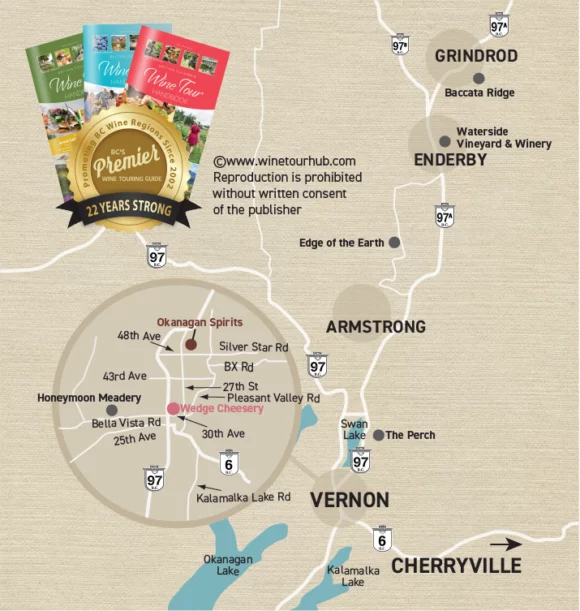
When you make your way to the North Okanagan, you’ll be astonished by the diversity of the landscape. It is home to the second largest city in the Valley that sits on the northern shores of the Okanagan and Kalamalka lakes. With a population of just under 45,000, Vernon isn’t exactly a metropolis, but it offers enough amenities to appease urbanites while retaining the homey, small town feel.
But just a short drive and all the urban trappings will melt away into mountains, woodlands, pastures and waterways with small, charming communities at their heart.
The North Okanagan features a more tempered climate than it neighbours to the south, while still offering up long, blissful days of sunshine. This enables a small collection of producers around the Vernon, Enderby, Armstrong and Grindrod areas to make aromatic white wines and fresh, light reds. Plus there is a growing community of cider, beer, mead and distilled beverage makers
If you love the water, the North Okanagan is your playground. In addition to the vast expanse of Lake Okanagan, you’ll find Kalamaka Lake, which is routinely voted one of the most beautiful lakes in the province. Known as the “lake of a thousand colours,” the water’s hue will shift throughout the year from emerald green to deep indigo and all the shades in between. Considered a glacier waterway, the colour is derived from light scattering, caused by the precipitation of calcium carbonate.
Sking, mountain biking and hiking enthusiasts will revel in the charming Silver Star Mountain ski resort, where powder like snow in the winter gives way to fields of wild flowers in the warmer months.
The area is also well known for its cheese. There are several artisan cheese makers in the area, as well as numerous shops dedicated to serving up fine local cheeses. Armstrong is also the setting for a small and quaint annual cheese festival.
Visitors to the area might consider a combination wine and cheese maker tour that is capped off at the end of the day with a cheese board paired with a glass of fine wine.
Common Grape Varieties: Riesling, Pinot Noir, Ortega, Pinot Gris, Siegerrebe
Key Wine Events: Okanagan Spring Wine Festival (May), Okanagan Fall Wine Festival (October)
Average Daily High Temperature (July): 26C
Average Hours of Sunshine: 2026
Average Annual Rainfall: 333 mm
Soil Type: Gravelly, Sandy loam, limestone and clay
Okanagan Valley Greatest Hits
Featured People and Places
Where to SIP in the Okanagan Valley
-
call778-437-2335
- Show Map
-
call250-497-8267
- Show Map
-
call778-515-6656
- Show Map
Where to EAT in the Okanagan Valley
-
call (250) 765-6890
- Show Map
-
call250-497-8267
- Show Map
Where to STAY in the Okanagan Valley
-
call250-572-0008
- Show Map
-
call250-763-5013
- Show Map
-
call250-763-2800
- Show Map
-
call250-498-2177
- Show Map
-
call250-766-1881
- Show Map
-
call778-475-4232
- Show Map
THINGS TO DO in the Okanagan Valley
-
call250-807-5353
- Show Map
-
call250-572-0008
- Show Map
-
call604-787-6132
- Show Map
-
call250-762-9830
- Show Map
-
call (250) 765-6890
- Show Map
Okanagan Valley INFORMATION
-
call778-484-6888
- Show Map
-
call250 712-9650
- Show Map
-
call250.495.5070
- Show Map
Okanagan Valley TRANSPORTATION SERVICES
-
call250-572-0008
- Show Map
-
call604-787-6132
- Show Map
-
call250-762-9830
- Show Map
Share this site with friends:

